Abstract
During the development of a hatchback car, a problem of ear-pressing noise caused by low-frequency road noise was encountered. Through the analysis of the vehicle’s transmission path, the mechanism of the problem, and experimental verification, it was confirmed that the low-frequency road noise problem inside the car was mainly caused by the road exciting the tire, transmitted through the suspension system to the subframe, arms, and other bottom plate components, and then transmitted to the body, causing the rear door bending mode to be excited and generate resonance, the body panel deformation squeezing the interior cavity, causing air pressure fluctuations in the car, and ultimately causing the low-frequency road noise ear-pressing problem. To solve the low-frequency road noise problem during vehicle operation, this paper studied the noise optimization scheme for the hatchback rear door, proposed a low-frequency road noise control solution, and successfully solved the low-frequency road noise problem of the hatchback car through in-vehicle verification, proving the effectiveness of the low-frequency road noise control solution and improving the driving comfort of the car, providing important guidance for NVH low-frequency road noise control.
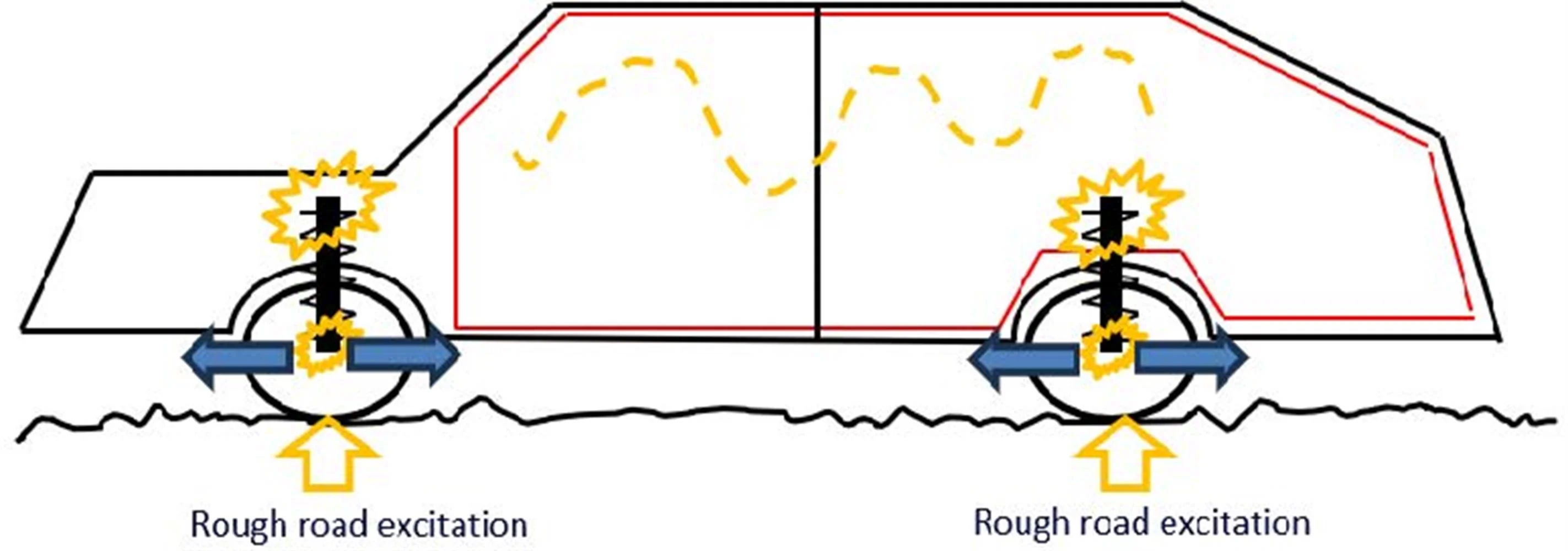
1. Introduction
With the economic globalization, automotive products are also facing the situation of fast iteration and diversification, and the competition among different brands is extremely fierce. Automobile manufacturers are also constantly improving product quality to meet the constantly increasing consumer demand for vehicle quality. Today, Automobile are no longer just seen as a simple means of transportation. More and more consumers are beginning to pay more attention to the pleasure of driving and the comfortable driving experience. Noise, vibration, and harshness (NVH) have emerged as critical factors influencing consumer perceptions, making NVH performance a key criterion for evaluating automotive quality [1].
In recent years, extensive research has been conducted in the field of automotive engineering regarding low-frequency road noise issues, which are also the primary problems that major automotive manufacturers and research institutions are striving to solve. An et al. [2] addressed the issue of low-speed, low-frequency road noise by optimizing the rear hatch, thereby resolving the low-frequency road noise problem. Dong et al. [3] conducted a systematic analysis of the causes of low-frequency road noise, focusing on the tailgate system, and resolved the issue by adjusting the stiffness of the cushion blocks. Currently, the main focus of research on the causes of low-frequency road noise is on the analysis and optimization of the rear hatch. However, there is limited research within the industry on why the rear hatch can produce severe resonance, leading to low-frequency road noise issues. There is a lack of systematic explanations for the most fundamental causes of low-frequency road noise.
This paper takes the development of a hatchback sedan as an example. Focusing on the low-frequency road noise issue that emerged during the development process, the paper systematically elucidates the most fundamental cause of low-frequency road noise through the analysis of suspension modes, working deformation characteristics, suspension vibration transfer, and body response. The root cause identified is the excitation of the suspension’s -direction mode. The coupling of the suspension mode with the rear hatch mode leads to intensified vibrations, which in turn cause low-frequency noise inside the cabin. By systematically explaining the causes of low-frequency road noise and proposing corresponding solutions, the paper ultimately verifies the feasibility and robustness of the optimization plan through real vehicle testing, effectively controlling the low-frequency road noise inside the cabin.
2. The generation mechanism of low-frequency road noise
2.1. Overview of road noise
Road noise refers to the sound generated by the friction and vibration between the tires and the road surface during a vehicle's travel. The level of road noise is an important indicator of riding comfort, which is related to the comfort of passengers. Severe road noise issues not only affect consumers’ recognition of the car brand but, more importantly, can lead to permanent hearing damage due to continuous high-level road noise, causing negative effects on the auditory structure and function of the ear. Based on the type of propagation, noise can be divided into two types: structure-borne noise and air-borne noise [4].
Structural-borne noise is transmitted through solid materials. A classic example of this type of transmission is the vibration caused by road excitation and tire structural characteristics. These vibrations are conveyed through the suspension system and ultimately affect the vehicle body and cavities, resulting in noise.
Airborne noise transmission refers to the noise radiated by the interaction between tires and the road surface, generated by the tire treads. This noise is transmitted to various parts of the vehicle body, where some of it is reflected back, some is absorbed by the body and soundproofing materials, and the remainder, which is neither reflected nor absorbed, is transmitted into the cabin, affecting human hearing. This type of transmission is known as airborne sound propagation [5].
2.2. Mechanism of road noise caused by acoustic-structural coupling
The automobile cockpit is composed of multiple stamped and welded sheet metal parts as well as enclosed components. The sheet metal and enclosed parts of the vehicle body are not fully rigid but possess a certain degree of elasticity. When the suspension system is stimulated by road conditions, it excites the modal vibrations of the suspension. These vibrations then transfer to the body panels, exciting their modal vibrations and resulting in resonance. The vibrations of the body panels reciprocally compress the acoustic cavity of the vehicle body, causing changes in the air volume within the cockpit. This coupling of the vehicle interior acoustic cavity with the vibrations of the sheet metal structure leads to fluctuations in pressure within the passenger compartment, ultimately generating a low-frequency, ear-pressing sound, as illustrated in Fig. 1 [6].
Fig. 1Schematic diagram of acoustic-vibration coupling model
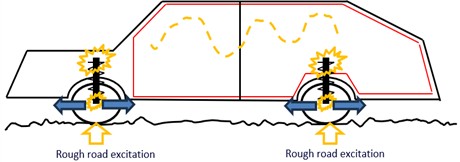
2.3. Road noise control methods
Road noise control methods involve multiple aspects, including improving road surfaces, optimizing vehicle design, and employing active noise cancellation techniques. The most common approach in practical engineering is to analyze the noise transmission paths, identify the causes of vibration, and then optimize control measures. Transfer Path Analysis (TPA) is an experimental-based method for analyzing vibration and noise that studies the transmission paths through actual testing. Typically, the entire system is divided into several relatively independent substructures, and the characteristics of each substructure are represented by transfer functions. The main concept of Transfer Path Analysis is to simplify the mechanical system into an analytical model composed of excitation source - transmission path - response point [7].
3. Transfer path analysis basic principles
Transfer Path Analysis (TPA) is a method used in automotive NVH (Noise, Vibration, and Harshness) engineering analysis and scientific research. Its fundamental concept is derived from the principles of linear systems. Assuming a vehicle is subjected to the action of excitation forces, each with , , and directional components (hereafter referred to as 1, 2, 3 respectively), each excitation force component corresponds to specific transmission paths. Therefore, this force component and its corresponding transmission path produce a system response component. Taking the sound pressure inside the vehicle as the system response, this sound pressure component can be expressed as [8]:
where, is the transfer function, is the frequency spectrum of the excitation force.
The sound pressure inside the vehicle, under the influence of a certain excitation force, can be expressed as the sum of all the transmitted sound pressure components:
The noise inside the vehicle is caused by all the acting forces, and can be represented by summing up the individual sound pressure components that are transmitted in:
Based on the “source-path-response” analysis method of Transfer Path Analysis (TPA), road noise control strategies can be divided into two types according to the mechanism of road noise generation: (1) transfer path control, which includes the vibration isolation performance of the suspension system, the modal characteristics of chassis components, the stiffness and sensitivity of chassis attachment points, and the sound insulation and absorption performance of the vehicle body; and (2) response control, which includes the bending and torsional modes of the vehicle body, local modes of the vehicle body, and the stiffness of the vehicle body panels.
4. Analysis of low-frequency road noise issues
4.1. Problem description
During the prototype tuning phase of a certain hatchback electric sedan, a low-frequency ear-pressure sound was present inside the vehicle when driving at low speeds of 30-40 km/h on rough cement road surfaces. The sound produced a continuous “dodo” pressure sensation on the eardrums, with the front row experiencing a more noticeable sensation than the rear row.
4.2. Problem analysis
To identify the frequency causing the low-frequency ear-pressure noise inside the vehicle, the Simcenter/Testlab Signature vibration and noise module was used for data collection. Microphones were placed next to the driver's right ear and on the right side of the rear seat to collect noise data as the test vehicle traveled at a constant speed of 40 km/h on a rough cement road surface, as shown in Fig. 2. Analysis of the test results revealed a significant noise peak near 35 Hz, with the noise level at the driver's right ear being noticeably higher than the noise at the right ear of the rear passenger. By filtering and replaying the data, the noise peak was identified as the frequency causing the low-frequency road noise. Subjective evaluation confirmed that this noise peak corresponds to the low-frequency ear-pressure sound, which aligns with the subjective evaluation results.
Fig. 2Noise levels at the driver’s right ear and the right ear of the rear passenger: — driver’s right ear; — right rear inner ear
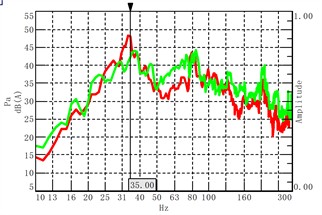
Fig. 3Test results on different road surfaces: — rough cement pavement, — smooth asphalt pavement
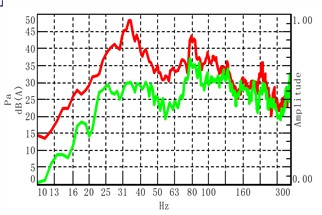
Based on the fundamental principles of Transfer Path Analysis, we conducted an investigation and resolution following the “source-path-response” approach. Analyzing the “source,” it was found that the interior noise at low frequencies was significantly higher when driving on rough cement surfaces compared to driving on smooth asphalt surfaces, as shown in Fig. 3. The low-frequency “drumming sound” in the front row is caused by the excitation from the cement road surface.
Upon analyzing the cement road surface, it was found that an excitation occurs every 32 cm. According to the Eq. (4), when traveling at a constant speed of 40 km/h, the excitation frequency from the road surface is calculated to be 34.7 Hz. Therefore, the road surface is the cause of the “drumming sound”. However, the “source” is an objectively existing factor that cannot be controlled:
where: : road surface excitation frequency; : vehicle travel speed (km/h); : excitation spacing (m); : integer.
An Operational Deflection Shape (ODS) test analysis was conducted on the “pathway” system composed of tires and suspension. It was found that both the front and rear suspension systems have a working deflection mode in the -direction near 34 Hz, as shown in Fig. 4. The vibration frequency at the wheel hubs of the front and rear wheels matches the peak frequency of the low-frequency ear-pressure noise inside the vehicle, as shown in Fig. 5. This means that the road surface excites the modal frequency of the system composed of tires and suspension, causing resonance, which is then transmitted to the vehicle body through the suspension mounting points.
Fig. 4ODS Test of the system composed of tires and suspension
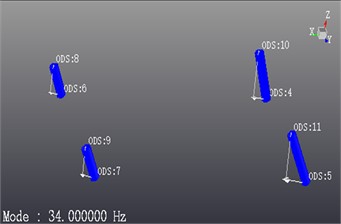
Fig. 5Vibration at the active and passive ends of the suspension: — active side; — passive end
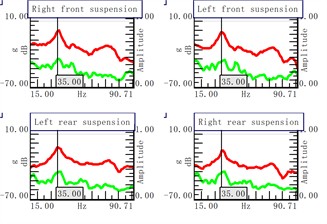
Based on the aforementioned pathway analysis, which indicates the presence of resonance in the suspension pathway, further analysis of the “response” is needed.
Using the Simcenter Testlab/Testlab Structures Acquisition/Impact Testing module to conduct modal testing on the rear door, data analysis revealed, it was found that there is a bending mode at 38 Hz in the rear door, as shown in Fig. 6, which is relatively close to the frequency of the problem area.
Simultaneously, in order to understand the actual working deformation of the rear door, an ODS (Operational Deflection Shapes) test was conducted, as shown in Fig. 7. The test results indicate that around 35 Hz, the rear door exhibits a working deformation that involves both vertical and front-to-back movements. This deformation reciprocally compresses the interior cavity of the vehicle.
Fig. 6Modal of the rear door
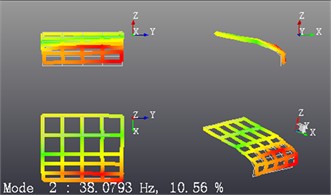
Fig. 7ODS test of the rear hatch
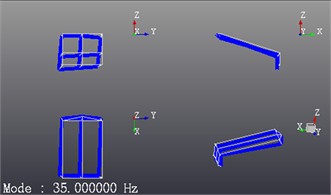
To further confirm whether the rear door contributes to the low-frequency road noise, a quick verification method commonly used in practical engineering is to unlock the rear door. After unlocking the rear door, the longitudinal acoustic cavity inside the vehicle is disrupted, preventing the rear door from reciprocally compressing the air inside the vehicle. The verification results show that the noise at 35 Hz is reduced by 7 dBA, as shown in Fig. 8, and subjective evaluations indicate that there is no longer any ear-pressing sound. Therefore, it is concluded that the low-frequency road noise issue is caused by the resonance of the rear door's modal being excited, which leads to reciprocal compression of the air inside the vehicle, causing pressure fluctuations within the vehicle and resulting in the low-frequency ear-pressing sound problem.
Fig. 8Rear hatch disruptiveness verification: — base; — rear door unlock
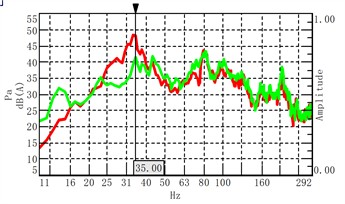
5. Scheme verification
A dynamic vibration absorber with a mass of 2 kg and a frequency of 35 Hz was added to the rear hatch, as shown in Fig. 9. A comparison verification was conducted on the rear hatch with and without the vibration absorber on a rough cement road surface. The verification results, as shown in Fig. 10, indicate that the red line represents the original state test results, while the green line represents the test results after the rear hatch was equipped with the vibration absorber. The noise peak near 35 Hz was reduced by 5 dBA after the rear hatch was fitted with the dynamic vibration absorber. Subjective evaluation showed a significant improvement in the low-frequency road noise and ear-pressure issue, achieving the expected effect.
In order to verify the consistency of the solution, five problematic prototype vehicles were selected and fitted with dampers from the same batch. Through objective testing, it was found that the noise peak near 35 Hz in all five prototype vehicles was reduced by 3-5dBA. This result validates the effectiveness and good consistency of the solution, meeting the requirements for mass production.
Fig. 9Rear hatch vibration absorber
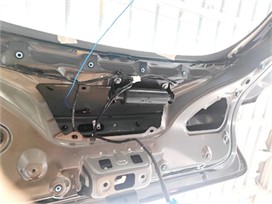
Fig. 10Optimization comparison: — base; —add damper
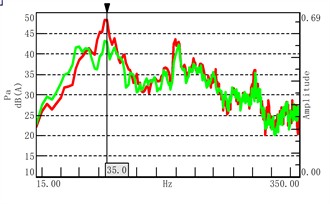
6. Conclusions
Addressing the common issue of low-frequency road noise in hatchback sedans is a challenge during the development process for major automotive manufacturers. By conducting a systematic analysis and experimental validation based on the “source-path-response” approach, combined with the mechanism of acoustic-structural coupling, the root cause of the low-frequency noise problem and its solution were identified, effectively resolving the issue of low-frequency road noise and ear-pressure sensation inside the vehicle.
1) By conducting tests and analysis on the system composed of tires and suspension, and combining the mechanism of acoustic-structural coupling, a systematic analysis of the causes of low-frequency road noise has been carried out. The research presented in this paper is of significant reference value for solving low-frequency road noise issues.
2) For hatchback vehicles with a larger rear hatch mass, it is difficult to solve the low-frequency road noise problem through local structural optimization and adjustment of the sealing system stiffness. Dynamic vibration absorbers have shown significant effectiveness in addressing noise issues caused by low-frequency structural resonance.
References
-
B. Xiao, “Study on NVH performance simulation and multi-objective optimiziation of an SUV body,” (in Chinese), Tianjin University of Science and Technology, Tianjin, 2021.
-
D. Y. An, Z. W. Chen, J. J. Wu, and S. C. Xia, “Analysis and optimization of low-speed road noise in a pure electric SUV,” in Proceedings of the 17th International Symposium on Automotive NVH Control Technology, 2020.
-
H. W. Dong, J. Zhang, H. Q. Zhou, D. S. Li, and Y. Li, “Test analysis and optimization of an SUV tail door system to road noise and rumble,” (in Chinese), in The 14th National Conference on Vibration Theory and Application (NVTA2021), 2021.
-
K. Qian, “Study on sound quality evaluation and control technology of a certain electric vehicle,” (in Chinese), Jilin University, Chang Chun, 2016.
-
S. Meng, “Sound pack optimization design for sedan automobile parcel shelf panel,” (in Chinese), Automobile Applied Technology, Vol. 47, No. 1, pp. 65–68, 2022, https://doi.org/10.16638/j.cnki.1671-7988.2022.001.015
-
W. F. Zhou, W. B. Wang, and H. D. Zhou, “Analysis and control of interior low-frequency road noise of a car,” (in Chinese), Noise and Vibration Control, Vol. 39, No. 3, pp. 142–146, 2019.
-
M. Xie, L. Wang, and Y. Huang, “Design and performance study of clutch disc assembly of wide-angle, large-hysteresis, multistage damper,” Chinese Journal of Mechanical Engineering, Vol. 34, No. 3, pp. 358–370, 2021.
-
X. M. Yang, S. Zhang, and X. H. Kuang, “Analysis and optimization of acceleration roar of an SUV based on transfer path analysis,” (in Chinese), Engineering and Test, Vol. 60, No. 3, pp. 22–24, 2020.
About this article
The authors have not disclosed any funding.
The datasets generated during and/or analyzed during the current study are available from the corresponding author on reasonable request.
The authors declare that they have no conflict of interest.
